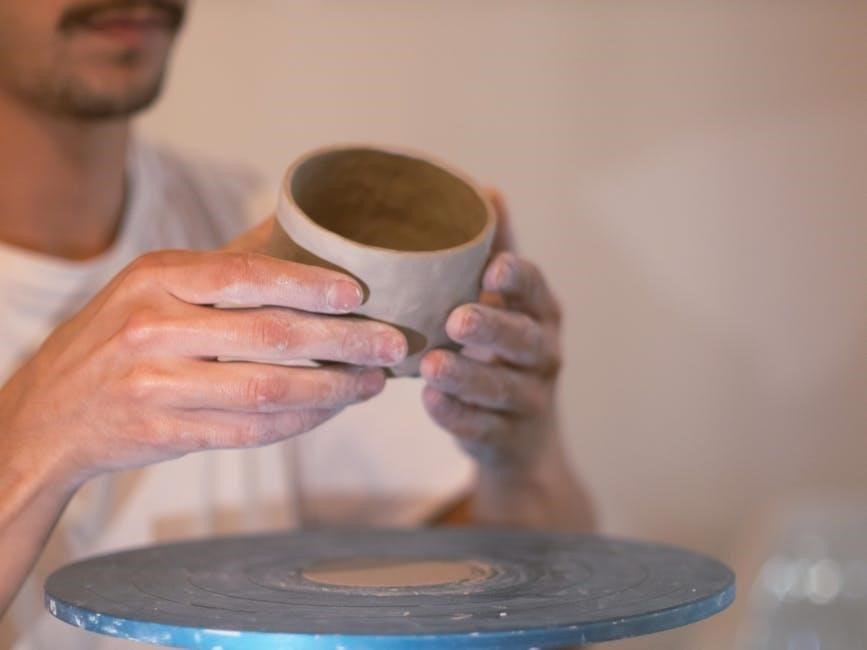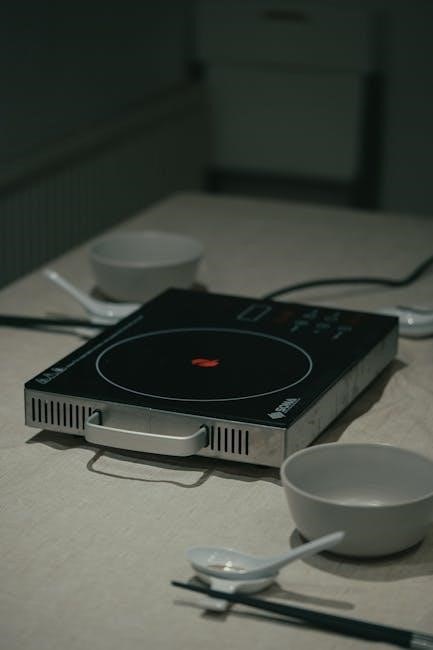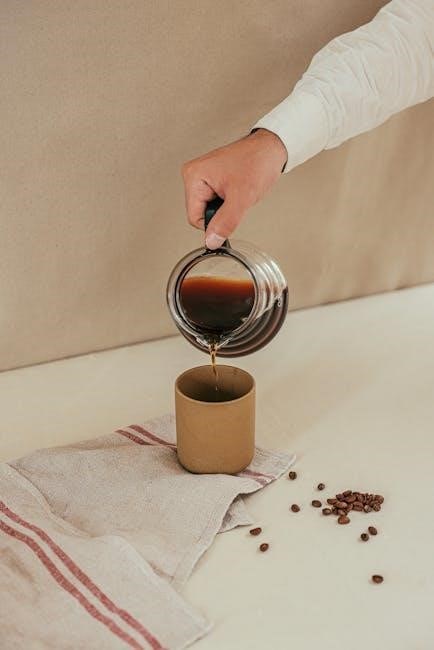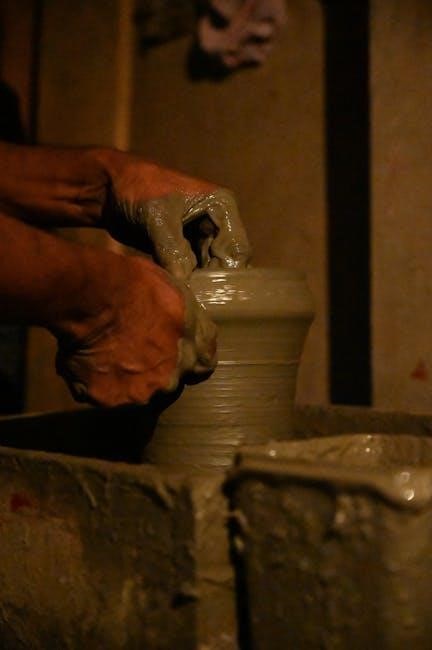
A Crock Pot slow cooker is a versatile kitchen appliance designed for hands-off cooking. With simple settings like low, high, and warm, it offers convenience and consistency, perfect for home cooks seeking effortless meal preparation while managing busy schedules.
1.1 What is a Crock Pot Slow Cooker?
A Crock Pot slow cooker is a countertop electrical cooking appliance designed for unattended, low-temperature cooking over several hours. It consists of a ceramic or stoneware cooking pot, a heating element, and a lid to retain moisture. The device is ideal for preparing a variety of dishes, from soups and stews to meats and vegetables, with minimal effort. Its simple operation involves setting the temperature (low, high, or warm) and allowing the food to cook slowly, ensuring tender results. This makes it a practical choice for busy households, enabling home cooks to prepare meals that are ready when they return home.
1.2 Benefits of Using a Crock Pot
Using a Crock Pot offers numerous benefits, making it a valuable addition to any kitchen. It provides hands-off cooking, ideal for busy individuals, as it allows meals to simmer unattended for hours. The low-temperature setting ensures even cooking, resulting in tender and flavorful dishes, especially for tougher cuts of meat. Additionally, it retains moisture and flavors, enhancing the overall taste of meals. The Crock Pot is energy-efficient, using less power than traditional ovens, and is versatile enough to prepare a wide range of dishes, from soups and stews to desserts. Its convenience and ability to simplify meal preparation make it a favorite for home cooks seeking stress-free cooking solutions.
Understanding the Components of a Crock Pot
A Crock Pot consists of a stoneware cooking pot, a heating element, and a lid. These components work together to ensure even heat distribution for consistent cooking results.

2.1 Main Parts of the Crock Pot
The Crock Pot slow cooker features a stoneware cooking pot, a heating element, and a lid. The stoneware pot is durable and retains heat evenly, while the lid helps trap moisture for tender results. The heating element is located at the base and warms the stoneware. Some models include a control panel with temperature settings (low, high, warm) and timers for precise cooking. These components work together to provide consistent, hands-off cooking. Proper care and maintenance of these parts ensure optimal performance and longevity of the appliance.
2.2 Accessories and Additional Features
Crock Pot slow cookers often come with accessories like a removable stoneware cooking pot and a fitted lid. Some models include a rack for roasts or vegetables. Optional accessories, such as silicone liners, make cleanup easier. Advanced features may include timers, digital controls, and sauté functions. These additions enhance versatility, allowing users to sear meat or cook vegetables before slow cooking. Certain models also offer programmable settings, enabling precise control over cooking time and temperature. These features cater to both basic and advanced users, providing flexibility and convenience for various recipes and cooking styles.

Safety Guidelines for Using a Crock Pot
Always operate your Crock Pot with caution. Never leave it unattended or use it without the lid properly fitted. Avoid touching hot surfaces and keep children away. Ensure the stoneware pot is placed on a heat-resistant surface and never operate the appliance empty or with a cracked lid.
3.1 General Safety Precautions
Before using your Crock Pot, always read the manual to understand its operation. Never leave the appliance unattended while in use. Avoid touching the hot surfaces, as they can cause burns. Ensure the lid is securely fitted to prevent splatters. Keep children away from the Crock Pot to avoid accidents. Never operate the appliance if it is empty or without the lid, as this can lead to damage or hazards. If the lid is cracked or damaged, refrain from using the Crock Pot until it is replaced. Always place the stoneware pot on a heat-resistant surface to prevent damage or fires. By following these guidelines, you can ensure safe and efficient cooking with your Crock Pot slow cooker.
3.2 Handling the Crock Pot Safely
Always handle the Crock Pot with care to avoid accidents. Use oven mitts or tongs when lifting or moving the hot stoneware pot. Never place the pot on an unstable or flammable surface. Avoid touching the cooker’s exterior or lid during operation, as they can become extremely hot. When stirring or checking food, use a spoon or spatula to prevent burns. After cooking, allow the Crock Pot to cool slightly before cleaning. Never submerge the electrical base in water or expose it to moisture. For added safety, ensure the cord is kept away from heat sources and children. Proper handling ensures longevity and safe operation of your Crock Pot slow cooker.
3.3 Electrical Safety Tips
Ensure electrical safety when using your Crock Pot by following these guidelines. Always plug the cooker into a grounded outlet to prevent electrical hazards. Avoid overloading the outlet with other appliances, as this can cause overheating. Never submerge the electrical base or cord in water, as this can lead to shock or damage. Keep the cord away from heat sources, children, and pets to prevent accidental damage or burns. If the cord is damaged, stop using the Crock Pot immediately and contact the manufacturer. Never operate the cooker without the stoneware pot or lid, as this can expose electrical components. Regularly inspect the cord and base for signs of wear. By adhering to these electrical safety tips, you can enjoy safe and reliable slow cooking.
Initial Setup and Preparation
Before first use, unpack and wash the lid and stoneware pot with warm soapy water. Dry thoroughly, then plug in the Crock Pot to test its settings.
4.1 Unpacking and Cleaning Before First Use
When you receive your Crock Pot, carefully unpack all components, including the stoneware pot, lid, and any accessories. Inspect for damage and ensure all parts are included. Before first use, wash the lid and stoneware pot with warm, soapy water using a soft sponge or cloth. Avoid using abrasive cleaners or scrubbers, as they may damage the surfaces. Rinse thoroughly and dry with a clean towel to prevent water spots. Do not forget to clean any additional accessories, such as utensils or racks, if provided. Once cleaned and dried, your Crock Pot is ready for its first use. Proper cleaning ensures optimal performance and longevity of your slow cooker.
4.2 Plugging in and Testing the Crock Pot

Once cleaned and ready, plug your Crock Pot into a nearby electrical outlet. Ensure the appliance is placed on a heat-resistant surface. Turn the dial to select the desired temperature setting: low, high, or warm. For initial testing, fill the stoneware pot with water to about halfway. Set the cooker to the low setting and let it run for 1-2 hours to ensure it heats evenly. After testing, unplug the unit and allow it to cool before cleaning. This step confirms proper function and prepares the Crock Pot for its first recipe. Always follow safety guidelines, such as not leaving the appliance unattended or allowing children to handle it.

Basic Cooking Settings and Modes
Crock Pots feature low, high, and warm settings for flexible cooking. Low is ideal for all-day meals, while high speeds up cooking. Manual models offer simplicity and affordability.
5.1 Understanding the Temperature Settings (Low, High, Warm)
Crock Pot slow cookers offer three primary temperature settings: low, high, and warm. The low setting is ideal for extended cooking periods, perfect for dishes that require 8-10 hours of preparation. The high setting accelerates cooking, reducing time to 4-6 hours, making it suitable for quicker meals. The warm setting keeps cooked food at a safe temperature, preventing overheating or burning. These settings provide flexibility for various recipes and schedules. For example, low is great for soups or stews, while high is better for tenderizing tougher meats quickly. Understanding these settings ensures optimal results for any dish. Always choose the setting based on your recipe and availability.
5.2 How to Choose the Right Cooking Mode
Selecting the right cooking mode on your Crock Pot depends on the recipe and your schedule. The low setting is perfect for dishes requiring 8-10 hours of cooking, such as soups, stews, or roasts. The high setting is ideal for quicker cooking, typically 4-6 hours, and works well for tenderizing meats or preparing hearty meals. The warm setting is designed to keep cooked food at a safe temperature, preventing overheating or burning. For recipes like chicken noodle soup or loaded baked potato soup, low or high settings are recommended. Always refer to the recipe guidelines to choose the appropriate mode. Proper mode selection ensures even cooking and optimal flavor. Experiment with settings to find what works best for your dishes.
Cooking Techniques for Optimal Results
Layer ingredients to ensure even cooking, balance liquid-to-solid ratios for moisture retention, and use searing or sautéing options to enhance flavors before slow cooking for the best outcomes.
6.1 Layering Ingredients for Even Cooking
Layering ingredients in your Crock Pot ensures even cooking and prevents uneven flavors. Start with tougher cuts of meat at the bottom, followed by root vegetables like carrots and potatoes. These take longer to cook and benefit from direct heat. Add softer vegetables like zucchini or bell peppers towards the top, as they cook quickly. Liquids should cover the bottom layer to maintain moisture, while seasonings can be sprinkled throughout for balanced flavor. This method ensures all components are tender and infused with flavor by the end of the cooking cycle.
6.2 Liquid-to-Solid Ratios in Slow Cooking
Maintaining the right liquid-to-solid ratio is crucial for slow cooking success. A general rule is to use 1 part liquid to 1-2 parts solids, ensuring ingredients are covered without drowning. Too little liquid can lead to dryness, while excessive liquid may result in a watery texture. Acids like tomatoes or vinegar help break down solids, while starchy ingredients like potatoes absorb liquid. Always leave at least 1-2 inches of space at the top to prevent overflow. Adjust ratios based on the recipe and desired consistency, ensuring a balanced, flavorful dish by the end of the cooking cycle.
6.3 Searing and Sautéing Options
Some Crock Pot models offer searing and sautéing options, allowing you to brown meats or vegetables before slow cooking. This feature enhances flavor and texture, creating a richer dish. For example, searing meat before slow cooking adds a caramelized crust, while sautéing vegetables brings out their natural sweetness. To use this feature, simply brown ingredients in the Crock Pot or a skillet before adding them to the slow cooker. Pat dry meats and vegetables for better browning. This step is especially useful for hearty dishes like stews or loaded baked potato soup, where texture and flavor depth are key. Always follow the manufacturer’s guidelines for these functions to ensure safe and effective use.
Meal Planning and Preparation Tips
Plan meals ahead by considering ingredients and cooking times. Chop vegetables and marinate meats before adding to the Crock Pot. This ensures flavors meld perfectly and saves time during busy days.
7.1 Planning Meals for Slow Cooking
Planning meals for slow cooking involves selecting recipes that thrive in a Crock Pot. Choose dishes with ingredients that benefit from long, gentle cooking, such as stews, soups, and braises. Consider the cooking time required, as most recipes cook between 6 to 8 hours on low or 3 to 4 hours on high. Opt for meals that can be prepared in advance, like chili or lasagna, to save time during busy days. Ensure you have all necessary ingredients on hand, and prep vegetables or marinate meats the night before for added convenience. This approach ensures flavorful, stress-free meals ready when you are.
7.2 Preparing Ingredients Before Cooking
Preparing ingredients before slow cooking is essential for optimal results. Start by washing and drying all vegetables, meats, and herbs. Chop or slice ingredients into uniform sizes to ensure even cooking. For meats, consider browning them in a pan beforehand to enhance flavor. Marinate meats or poultry if desired, then place them in the Crock Pot. Liquids should be added according to the recipe, avoiding overfilling the cooker. Layer ingredients as needed, placing denser foods like root vegetables at the bottom. Season with spices and herbs, adjusting to taste. Proper preparation ensures a balanced, flavorful dish that cooks evenly throughout the day.
Popular Crock Pot Recipes
Crock Pot recipes like loaded baked potato soup, slow cooker lasagna, and classic chicken noodle soup are beloved for their rich flavors and effortless preparation, making mealtime delightful.
8.1 Classic Chicken Noodle Soup
A timeless favorite, classic chicken noodle soup is a staple in many households. Made effortlessly in a Crock Pot, this comforting dish combines tender chicken, aromatic vegetables, and soft noodles in a flavorful broth. Simply add boneless chicken, diced carrots, celery, onions, garlic, chicken broth, and your favorite noodles to the slow cooker. Season with salt, pepper, and herbs like thyme or parsley for added depth. Cook on low for 6-8 hours or high for 3-4 hours. For extra richness, brown the chicken in a skillet before adding it to the Crock Pot. This hearty, comforting soup is perfect for cozy meals or soothing colds, delivering a delicious, homestyle flavor every time.
8.2 Loaded Baked Potato Soup

Loaded baked potato soup is a creamy, satisfying dish that transforms the flavors of a classic baked potato into a hearty soup. Perfect for chilly days, this recipe is a crowd-pleaser. Simply layer diced potatoes, chicken broth, onions, garlic, and bacon bits in your Crock Pot. Cook on low for 6-8 hours or high for 3-4 hours until the potatoes are tender. Stir in shredded cheddar cheese until melted and creamy, then top with sour cream, chives, and extra bacon if desired. This soup is a creative twist on traditional potato soup, offering a rich, indulgent flavor that’s sure to become a family favorite. Customize with your favorite toppings for added deliciousness!
8.3 Slow Cooker Lasagna
Slow cooker lasagna is a classic Italian dish adapted perfectly for the Crock Pot, offering a hands-off approach to a hearty, layered meal. Ground beef, lasagna noodles, marinara sauce, ricotta, and mozzarella cheese come together in a flavorful, satisfying casserole. Layer the ingredients in the Crock Pot, starting with a thin layer of sauce, followed by noodles, meat, and cheese, repeating until all ingredients are used. Cook on low for 5-6 hours or high for 3-4 hours. The result is tender noodles and a bubbly, cheesy top. Let it rest for 10-15 minutes before slicing to ensure clean, neat portions. This recipe is a convenient twist on traditional oven-baked lasagna, perfect for busy days. Enjoy with garlic bread for a complete meal!

Care and Maintenance of Your Crock Pot
Regularly clean the stoneware and lid with warm soapy water. Avoid abrasive cleaners or metal scourers. Dry thoroughly after washing to prevent water spots and damage.

9.1 Cleaning the Crock Pot After Use
Cleaning your Crock Pot after each use is essential for maintaining its performance and hygiene. Start by unplugging the unit and allowing it to cool slightly. Remove the stoneware insert and wash it with warm soapy water, using a soft sponge or cloth to avoid scratching the surface. The lid should also be cleaned thoroughly, paying attention to the rim and handle areas. For tough food residue, soak the stoneware in warm water before scrubbing. Avoid using abrasive cleaners or metal scourers, as they can damage the ceramic coating. Regular cleaning prevents bacteria growth and ensures your Crock Pot remains in optimal condition for future use.
9.2 Storing the Crock Pot Properly
Proper storage of your Crock Pot is essential to maintain its condition and longevity. After cleaning, ensure the stoneware insert and lid are completely dry before storing. The stoneware can be stored in the base or separately in a dry place. Avoid stacking heavy objects on the stoneware to prevent cracking. Store the unit in a cool, dry location away from direct sunlight and moisture to prevent mold growth. For the electrical components, wrap the cord neatly around the base or store it separately to avoid tangling or damage. Always keep the Crock Pot out of reach of children and pets when not in use.

Troubleshooting Common Issues
Identify common issues like uneven cooking or lid misalignment. Check power supply, ensure lid is sealed tightly, and verify stoneware is undamaged for optimal performance.
10.1 Common Problems and Solutions
One common issue is uneven cooking, often due to incorrect liquid levels or improper ingredient layering. Ensure the stoneware is preheated and ingredients are evenly distributed. Another problem is a cracked or damaged lid, which can lead to heat loss. Replace the lid immediately if damaged. Additionally, if the Crock Pot isn’t turning on, check the power cord and outlet connections. For models with manual controls, ensure the dial is set correctly. Regular cleaning can prevent residue buildup, which might affect performance. Always refer to the user manual for specific troubleshooting steps tailored to your model.
10.2 Fixing Lid or Seal Issues
A common issue with Crock Pots is lid or seal problems, which can lead to heat loss and uneven cooking. If the lid is cracked or damaged, replace it immediately to maintain proper sealing. For minor seal issues, ensure the lid is clean and free of food residue, as dirt can prevent a tight seal. Avoid placing the stoneware on uneven surfaces, as this can misalign the lid. Regularly inspect the seal for wear and tear, and replace it if necessary. If the lid doesn’t fit securely, check for any blockages or obstructions inside the cooker. Proper alignment and cleanliness are key to maintaining a secure seal during cooking.
Advanced Tips for Experienced Users
Experienced users can customize recipes by adjusting cooking times and temperatures. Utilize timers and programming features for precise control. Experiment with ingredients and spices to enhance flavors.
11.1 Customizing Recipes for Your Crock Pot
Customizing recipes for your Crock Pot allows you to tailor meals to your taste preferences. Adjust ingredients, spices, and seasonings to enhance flavors. Experiment with layering techniques and liquid ratios for optimal results. For example, adding garlic or herbs can elevate dishes like loaded baked potato soup or slow cooker lasagna. Consider the cooking time and temperature settings to ensure ingredients cook evenly. Manual adjustments, such as searing meat before slow cooking, can add texture and depth. By tweaking recipes, you can create personalized meals that suit your dietary needs and preferences, making the Crock Pot a versatile tool for home cooking.
11.2 Using Timers and Programming Features
Using timers and programming features on your Crock Pot enhances convenience, allowing you to set specific cooking times and temperatures. Modern models offer digital displays for easy programming, enabling you to start cooking at a later time. This feature is ideal for busy schedules, as it ensures your meal is ready when you need it. Some models allow switching between cooking modes automatically, such as moving from cook to warm. Timers help prevent overcooking by stopping the process at the right moment. For manual models, basic adjustments suffice, but programmable units offer greater flexibility. Utilize these features to optimize your cooking experience and enjoy perfectly prepared dishes every time.

Conclusion
Your Crock Pot slow cooker is a versatile, time-saving kitchen companion. With proper use and care, it delivers delicious, hands-off meals. Experiment, enjoy, and happy cooking!
12.1 Summary of Key Points
A Crock Pot slow cooker is a versatile, time-saving appliance ideal for hands-off meal preparation. It offers simple temperature settings (low, high, warm) and requires minimal supervision. Proper setup includes unpacking, cleaning, and testing before first use. Safety precautions like avoiding operation without the lid and ensuring the pot is placed on a heat-resistant surface are essential. Understanding cooking techniques, such as layering ingredients and maintaining liquid ratios, ensures optimal results. Regular cleaning and storage prolong the appliance’s lifespan. Troubleshooting common issues and exploring advanced features can enhance your cooking experience. With consistent use and care, your Crock Pot becomes a reliable kitchen companion for delicious, stress-free meals.
12.2 Encouragement to Experiment and Enjoy
Embrace the full potential of your Crock Pot by experimenting with new recipes and techniques. This versatile appliance allows you to create a wide variety of delicious meals with minimal effort. Whether you’re preparing hearty soups, flavorful stews, or innovative desserts, the Crock Pot simplifies the process. Don’t hesitate to customize recipes to suit your taste preferences or dietary needs. The affordability and ease of use make it perfect for both beginners and experienced cooks. Take the opportunity to explore different cuisines and ingredient combinations, and enjoy the satisfaction of sharing homemade meals with family and friends. Happy cooking!



